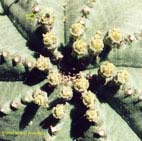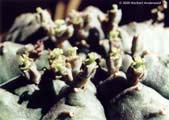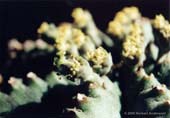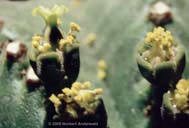Male and female |
 male plant with irregular bisexual cyathium (arrow) and normal male cyathia |
 female plant with normal (single-flowered) female cyathia |
|
Male plant, |
 |
 |
|
Enlarged details |
 bisexual cyathium (left) and normal male cyathium (right) |
 male cyathium with irregular single female flower |
|
About |
These images show an irregular female flower in the center of a male cyathium on a male plant of Euphorbia meloformis (Euphorbiaceae). This plant may be hybridogenous (garden hybrid?). For comparison, a photo of a female plant in flower (from the same source) is shown as well (top right). When polliniated with pollen from the same mother plant, the irregular female flower yielded no fruit. |
||
Botany |
Like several other succulent Euphorbias from South Africa, E. meloformis is dioecious, which means that unisexual flowers are found in unisexual inflorescences on either "male" or "female" plants. (Annotation: Dioecy is not rare in the genus Euphorbia; it is limited neither to South African, nor to succulent species. The following remarks are based mainly on observations of E. obesa, E. valida, and E. meloformis. Relevance for other species may be limited.) A male flower of the Euphorbia meloformis/obesa/valida group consists of one nude stamen only; several such flowers are grouped in a pseudanthium (Cyathium). They develop asynchronously, with usually only one or just a few (ca. 3-5) mature, pollen releasing flowers (stamina) in different stages of maturity present at the same time. After releasing the pollen, they are dropped soon. A female Cyathium of this group usually contains a single flower, which consists of a syncarpous gynoecium of three carpels with one ovule each, and three styles that are joined at the base. The fruit is a dry capsule that "explodes" when it turns mature, catapulting the seeds that it contains (usually 3) up to several meters away from the mother plant. |
||
 Euphorbia obesa young female with 5 ribs only |
|||
Notes |
I have been growing succulent Euphorbias since 1983 (mostly E. obesa, E. valida and E. meloformis); this was the first time that I have seen such a bisexual inflorescence. Until now, the most unusual observations with them were 2 four-carpelled and 1 two-carpelled flowers (and resulting fruits) of E. obesa, an E. obesa seedling with three cotyledons, and another one with 5 ribs only instead of the normal 8 (or sometimes more in older, columnar plants). | ||
July 11, 2001 |
updated: August 4, 2002 |
||